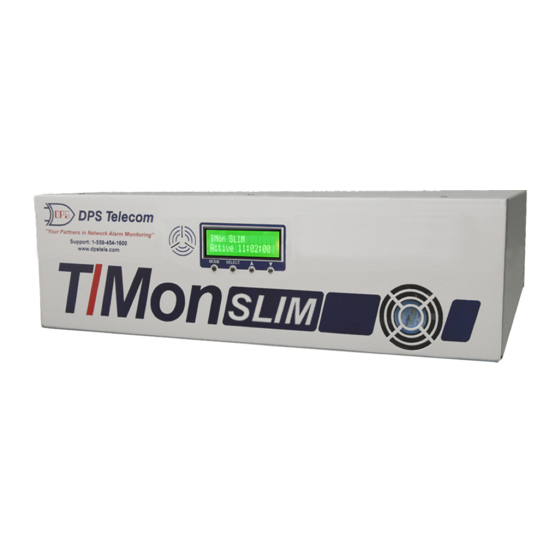Advertisement
Quick Links
DPS Telecom
"Your Partners in Network Alarm Management"
Problem: Trouble Setting Up ASCII for the First Time
________________________________________________________________________
ASCII Processing is one of the most powerful and flexible features
supported by T/Mon. It gives T/Mon the ability to monitor
the English output of your telecom network and declare
alarms based on your selection criteria from ASCII devices
like switches, PBXs, and routers. Unlike other protocols
that may be used to report alarm information, ASCII is
free-form, non-standard, and may say almost anything.
This Techno Knowledge Paper can help you if:
You are setting up ASCII on T/Mon for the first
•
time
________________________________________________________________________
(for more details, review the troubleshooting checklist, starting on page 2 of this guide)
S
H
S
H
T
A
R
T
E
R
E
T
A
R
T
E
R
E
Create ASCII
Device Rule 0
(general)
Select the rule set
for this device
Enter 'Monitor Mode'
Platform: T/Mon NOC, SLIM, XM
Quick Reference Chart
Create ASCII
Device Rule 20
(general)
Enter in name of
one of the sites that
will receive alarms
Interface' and
select ASCII job
"Techno Knowledge" Paper
Create job and
data connection
for your ASCII
device
Go to 'Craft
Enter Port
Desciption for
ASCII device
Enter TCP
connection for
new ASCII job
Sign-in (if necessary)
and view text received
by ASCII device
Advertisement

Summary of Contents for DPS Telecom T/Mon NOC
- Page 1 “Techno Knowledge” Paper “Your Partners in Network Alarm Management” Problem: Trouble Setting Up ASCII for the First Time Platform: T/Mon NOC, SLIM, XM ________________________________________________________________________ ASCII Processing is one of the most powerful and flexible features supported by T/Mon. It gives T/Mon the ability to monitor...
-
Page 2: Troubleshooting Checklist
___________________________________________________________________________ Troubleshooting Checklist In this example, we’ll be using the T/Mon to Telnet to a DMS10 switch to extract the ASCII alarm information. First we need to set up two very general rules for the T/Mon to capture all the data being received by the DMS10. - Page 3 Fig. 2 - Setup Rule for allowing all information that is seen by the T/Mon to be processed and recorded to a log file. Next, we need to create the “job” and data connection for the ASCII device. Keep hitting <ESC>...
- Page 4 troubleshooting tool that will capture all activity on this port and write it to a log file called al400.rep (ASCII LOG job 400: Keep in mind that it will always display the job as a 3 digit number, so if job 50 is used, it will appear like “al050”). Fig.
- Page 5 characters from the device, you might try a regular Telnet connection). Hit <ENTER>. b. Enter the IP address of your device and hit <ENTER>. c. Enter the TCP port we will be connecting to the device on and hit <ENTER>. d.
- Page 6 Fig. 8 – Port setup of the new data connection. Hit F1 and enter the name of one of the sites you will be receiving alarms. a. When you get to the device type, hit <TAB> and select the name of the rule you wish to use for this device.
- Page 7 sign in to retrieve alarms, you’ll do so now. Keep in mind that all text being received is stored in a report file that can be retrieved from the FTP server on your T/Mon or viewed directly on the system. (To view it directly on the system, escape out of Monitor Mode and go to ‘Files’, ‘Utilities’, ‘Report Maintenance’.












Need help?
Do you have a question about the T/Mon NOC and is the answer not in the manual?
Questions and answers